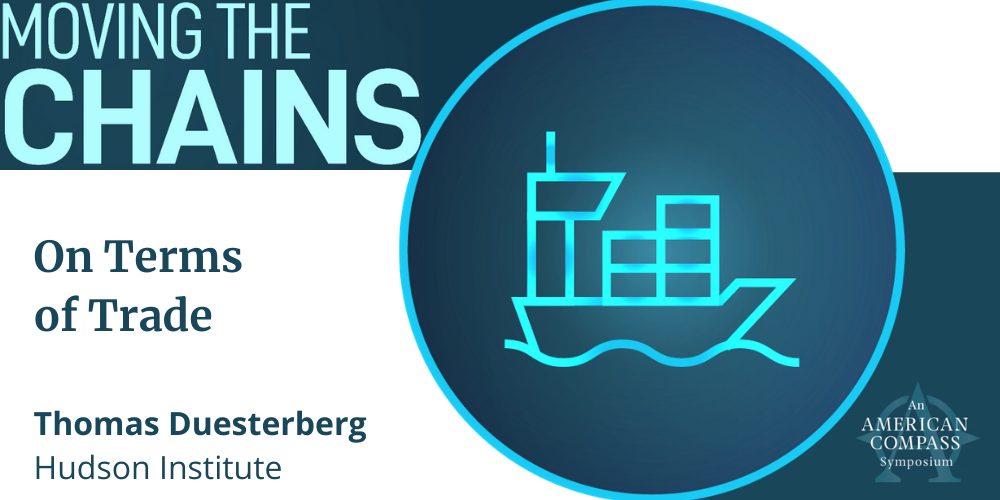
A tax credit for domestic investment is the best way to reduce production costs.
RECOMMENDED READING
Paul Krugman may insist that “the notion that nations compete is incorrect,” but reality proves him wrong. Countries not only compete, but increasingly do so for high value-added, innovation-based industries, such as advanced machinery, aerospace, biopharmaceuticals, semiconductors and computing, software, and automobiles. For example, the Made in China 2025 plan identifies eight key industries in which Beijing intends to win—and these do not include plastic toys and soybeans. If the United States is not only to avoid losing this competition—and suffering the myriad economic, military, and social consequences of defeat—but also to win back offshored supply chains and boost exports, it must turn the tax code into a tool for technological competitiveness and reshoring.
Checking the Score
Nations use a number of strategies to gain global market share in advanced industries, including intellectual property theft and forced tech transfer. But a common approach is to lower advanced industry firms’ costs through a panoply of tools. China is the master, deploying the equivalent of hundreds of billions of dollars in subsidies to its national champion firms. In 2019, for instance, the Chinese government established a second fund of $29 billion to subsidize domestic semiconductor companies.1Yoko Kubota, “China Sets Up New $29 Billion Semiconductor Fund,” The Wall Street Journal (October 25, 2019). Chinese subsidies go beyond cash injections. They include tax breaks, low-interest and forgivable loans, equity injections, cheap land and energy, and other incentives. In some industries the result is massive: government alone accounts for more than 30% of the revenues of China’s largest two semiconductor firms.2“Measuring distortions in international markets: The semiconductor value chain,” OECD Trade Policy Papers No. 234.
Any CEO will tell you that competing with a subsidized foreign competitor is difficult. The subsidized competitor can lower its prices and use this advantage to gain market share at the expense of rivals. Unless the disadvantaged firm decides to move its operation to the country providing the subsidies in hope that it qualifies, there are only three ways to retain its competitive position: scale, innovation, and management. The view among most economists and pundits is that U.S. firms have advantages in all three and that these outweigh any disadvantages from foreign subsidies.
“In other words, it is not—and was never—safe to assume that U.S. advanced industries will maintain global market share, absent some change in policy.”
This is wishful thinking at best. First, China’s captive market is huge, providing the same—if not greater—economies of scale than U.S. firms enjoy. The Chinese domestic market is already vast and growing, and the Belt and Road Initiative has only expanded its overseas markets. Second, China is not destined to remain a distant follower in innovation. U.S. policymakers have already made the mistake of taking America’s lead in innovation for granted. From the 1970s to 1990s, they assumed that nations like Japan, South Korea, and Taiwan could not be global innovation leaders. But as they soon learned, fast followers can become leaders. China is already catching up. As the Information Technology and Innovation Foundation has shown in an analysis of 36 indicators of national innovation, China is catching up to the United States, and in some areas like 5G, mobile payments, and drones, it is already ahead.3Robert D. Atkinson and Caleb Foote, “Is China Catching Up to the United States in Innovation,” Information Technology & Innovation Foundation (ITIF) (April 2019). Third, while the U.S. is ahead of China in management quality, the gap has closed over the last decade from 21% to 18%. That gap should continue to close as younger Chinese managers, many trained in world-class business schools, ascend China’s corporate ranks over the next two decades.4Authors calculations from: Nicholas Bloom and John Van Reenen, “Why Do Management Practices Differ across Firms and Countries?” Journal of Economic Perspectives 24, no. 1 (2010); and Nicholas Bloom et al., “Management as a Technology?” Harvard Business School Working Paper 16-133 (October 8, 2017).
In other words, it is not—and was never—safe to assume that U.S. advanced industries will maintain global market share, absent some change in policy. If our traditional advantages of scale, innovation, and management no longer suffice, then Congress must find a way to lower the costs for leading American firms if they are to remain competitive in advanced industries. Otherwise, other nations, especially China, will force even the best U.S. firms into a dilemma: offshore even more production or else lose significant market share, potentially going out of business. Either way, the U.S. economy is hurt.
Reviewing the Cost-Reduction Playbook
So how to reduce costs? There are three potential approaches—each with its own unique drawbacks and advantages.
The first approach is lowering the value of the dollar. Given the United States’ $617 billion trade deficit, the dollar is clearly overvalued, making U.S. exports more expensive and imports cheaper. There are multiple ways to bring down the value of the dollar. One is to place a market access charge on foreign purchases of U.S. stocks, bonds, and other assets, as Senators Baldwin (D-WI) and Hawley (R-MO) have proposed.5“U.S. Senators Tammy Baldwin and Josh Hawley Lead Bipartisan Effort to Restore Competitiveness to U.S. Exports, Boost American Manufacturers and Farmers,” Baldwin.senate.gov. While a weaker dollar would help to bring back supply chains and boost exports, it would not be enough, particularly as China would likely ramp up subsidies and other unfair practices. Moreover, it would do little to spur productivity growth and innovation.
A second approach is direct subsidization. Subsidies, such as funding more pre-competitive R&D, would help, especially given that the federal government invests less in R&D as a share of GDP than it did prior to Sputnik. But these only help firms indirectly. Direct subsidies, such as Japanese Prime Minister Shinzo Abe’s proposal to pay firms to reshore production, are effective, and Congress should establish such a program targeted to helping to bring back critical, advanced technology industries, such as semiconductors.6Asa Fitch et al., “Trump and Chip Makers Including Intel Seek Semiconductor Self-Sufficiency,” The Wall Street Journal(May 11, 2020). But there is insufficient political will to do this at the necessary scale.7Robert D. Atkinson, “The Case for a National Industrial Strategy to Counter China’s Technological Rise,” Information Technology & Innovation Foundation (ITIF) (April 2020). And, like currency value reduction, reshoring subsidies do little to spur productivity growth and innovation.
The third tool is the tax code. Tax incentives, in particular, can directly help manufacturers and other export industries, primary targets of a reshoring strategy. Despite the difficulties of WTO compliance if targeting manufacturing, tax incentives have clear advantages. They not only reduce costs, expanding both reshoring and exporting, but also spur investment in key factors driving productivity growth and innovation. They are relatively easy to administer and avoid the chimera of picking particular firms as winners. If set at the right levels, they can also be a powerful incentive to change business behavior.
U.S. policymakers should pursue all three of these approaches: devalue the dollar, issue direct subsidies, and reform the tax code. But reforming the tax code—and designing tax incentives, in particular—presents the fewest drawbacks and greater advantages.
Tackling Tax Incentives
What kind of tax incentive should be used? America’s ideological camps are divided over the question. Conservative supply-siders favor lowering taxes on capital gains, dividends, and high-income earners, which they imagine will boost savings and investment.8Robert D. Atkinson, Supply-Side Follies: Why Conservative Economics Fails, Liberal Economics Falters, and Innovation Economics is the Answer (New York: Rowman & Littlefield, 2006). But America’s problem is not a lack of capital—the Chinese will loan us as much as we want—it’s a lack of demand by firms for investment capital. Because liberal populists view the world through a fairness lens, they see the answer to social injustice as raising taxes on big companies (after all, for them, small neighborhood firms are what really matter). That may or may not serve social justice, but it will not make American firms more competitive.
Meanwhile, most moderates embrace the “lower the rate, broaden the base” mantra which holds that the best tax code is one with low rates and few deductions. In their view, the pre-tax marketplace is efficient and any incentives distort the “invisible hand.” As the Simpson-Bowles Commission asserted, “The [tax] code presents individuals and businesses with perverse economic incentives instead of a level playing field.”9Moment of Truth: Report of the National Commission on Fiscal Responsibility and Reform, The National Commission on Fiscal Responsibility and Reform (2010). Congress followed this advice when it scaled back the R&D tax credit in 2017 with the Tax Cut and Jobs Act. But the claim that tax incentives are a form of wasteful, special interest-driven spending, or “corporate welfare,” is ideological, not evidence-based.
“But America’s problem is not a lack of capital—the Chinese will loan us as much as we want—it’s a lack of demand by firms for investment capital.”
The complaint that tax incentives distort firm behavior and reduce economic welfare misses the point: government should want the firms located in their jurisdiction to do certain things that maximize the national interest. And because firms cannot capture all of the value from investments in R&D, workforce training, as well as machinery, equipment, and software, they underinvest in these activities relative to what would otherwise maximize economic welfare. For example, companies investing in research, on average, capture less than half of the returns from that research, even with robust intellectual property protection,10Charles Jones and John Williams, “Measuring the Social Return to R&D,” Quarterly Journal of Economics 113, no. 4 (1998). and the same is true for investments in skills and equipment.11Luke A. Stewart and Robert D. Atkinson, “The Greater Stagnation: The Decline in Capital Investment is the Real Threat to Economic Growth,” Information Technology & Innovation Foundation (ITIF) (October 2013). As Canadian government economist Aleb ab Iorwerth writes, “there is no presumption that distortions are necessarily welfare-reducing. Distortions that favor the contributors to long-run growth will be welfare-enhancing.”12Aleb ab Iorwerth, “Canada’s Low Business R&D Intensity: the Role of Industry Composition,” Department of Finance Canada Working Paper 2005-03 (2003).
The tax code should be focused on company demand for capital. It should reduce the effective tax rate for companies, including large corporations, when they invest in research and development, capital equipment, and workforce training. In other words, the tax code should incent American companies to support the three main building blocks of productivity growth, innovation and competitiveness.
While the lower corporate tax rate Congress established in 2017 helped, it is not enough. An across-the-board rate reduction is not a particularly strong incentive to make the kinds of critical investments needed in the United States to ensure competitiveness and boost reshoring and exports. Direct tax incentives tied to actual investment are better.
When it comes to using the tax code to spur competitiveness, the United States is a laggard. Many nations have adopted investment tax credits. But the United States eliminated its credit in 1986, after neoclassical economists like Larry Summers argued they were distortionary—though Summers did admit that an investment tax credit boosted overall growth.13Rob Atkinson, “Could a Fed Under Larry Summers Worsen America’s Investment Drought?” Washington Monthly(September 9, 2013). And while the United States has long had an R&D tax credit, it is anemic, with 25 OECD nations providing a more generous incentive.14Joe Kennedy, “U.S. Continues to Lag Its Competitors on Tax Credits for Research and Development,” Information Technology & Innovation Foundation (ITIF) (September 13, 2019); Rob Atkinson, “Hearing on Tax Reform Options: Incentives for Capital Investment and Manufacturing,” Information Technology & Innovation Foundation (ITIF) (March 6, 2012).
The United States can no longer afford to fall behind. It must create a new, more generous tax incentive.
The American Innovation and Competitiveness Tax Credit
To limit further deterioration of U.S. advanced industry competitiveness, Congress should enact an American Innovation and Competitiveness Tax Credit for expenditures made in the United States on R&D, machinery and equipment (including software), and workforce training. Any such incentive should be modeled on the current Alternative Simplified Credit for R&D which provides a credit of 14% of expenditures on R&D in excess of 50% of base period expenditures.
It is not clear what the optimal credit level should be. One consideration might be that the effective U.S. tax subsidy for R&D is just 42% of the median of nations with an R&D tax subsidy.15John Lester and Jacek Warda, “Assessing the U.S. R&D Credit in the International Context,” Information Technology & Innovation Foundation (ITIF), forthcoming. On the other hand, any incentive would have to address fiscal realities of lost tax revenues—at least in the short run. As such, it seems reasonable to set the rate of this new credit at 30% (of expenditures in excess of 50% in the base period). Thus, if a firm invested an average of $10 million in R&D, workforce training, and new machinery over the last 3 years (the base period) and in year 4 invested $12 million, it would receive a credit of $2.1 million (30% of 7 million).
“The United States can no longer afford to fall behind. It must create a new, more generous tax incentive.”
This rate would bring firm discount rates more into line with the actual cost of capital, rather than the higher rates most firms in the U.S. appear to use.16Rachelle C. Sampson and Yuan Shi, “Are US Firms Becoming More Short-Term Oriented? Evidence of Shifting Firm Time Horizons from Implied Discount Rates, 1980-2013,” SSRN (October 2, 2019). As a result, the tax incentive would encourage investments that would otherwise fail to meet corporate financial hurdle rates. For example, assume a company has an opportunity to invest $1 million in a machine that reduces annual labor and other costs by approximately $200,000. The investment would break even after 4 years and 10 months, longer than most companies’ investment time horizons. But with the tax credit, the breakeven point would be 3 years and 5 months. In other words, a tax credit would make significantly more investments attractive to American businesses.
In the long run, the tax credit would lower the cost of returning production stateside and attract foreign direct investment, while also spurring innovation and productivity growth. It would have the added benefit of encouraging more firms to become high-performance work organizations, where investments in new process technologies and worker skills go hand in hand.
The American Investment and Innovation Tax Credit is not a silver bullet for reversing America’s competitiveness slide. Other steps, including better workforce training, trade policies, government funding of R&D, and regulatory reform, are all needed. But without such a tax credit to help level the playing field, these other measures will not be enough.
Recommended Reading
Rebuilding American Industry: Devil Is in the Details
David Goldman features his Moving the Chains symposium essay, “The Reshoring Imperative,” with new commentary directed at Joe Biden’s “Buy American” campaign.
On Terms of Trade
The international trading system must recover the core principles of reciprocity, security, and democracy.
Shooting Down the Flying Geese Theory of Trade
Although neoliberal globalists are often said to be opposed to industrial policy and strategic trade, that is not necessarily true. Neoliberals of the kind who have dominated U.S. policy under the two Bushes, Bill Clinton and Barack Obama are not orthodox anti-government libertarians. They support a particular kind of industrial policy, whose emblem is not the American eagle but the Japanese goose.













